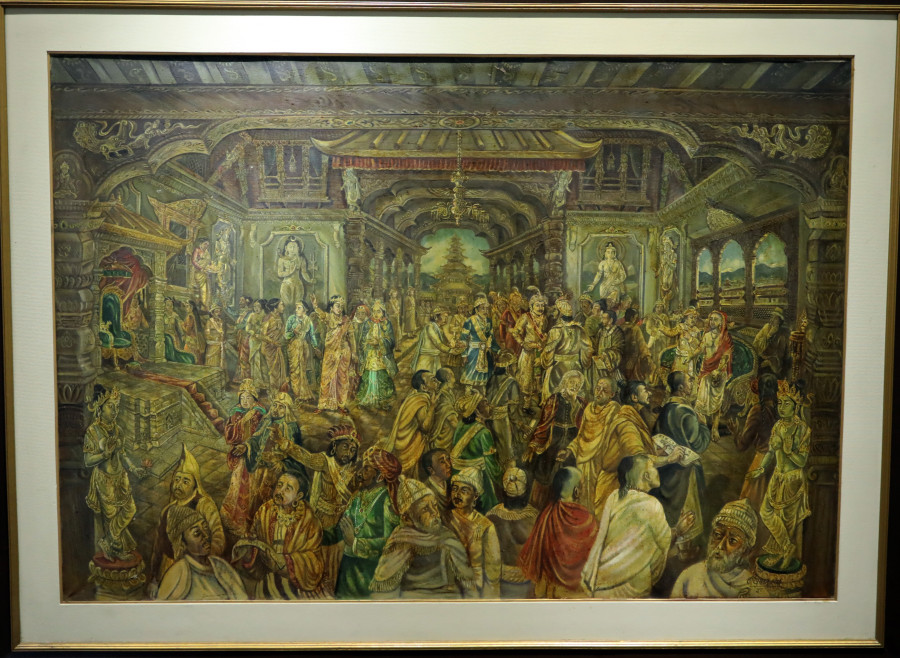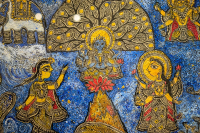Culture & Lifestyle
Witnessing history unfold, in colour and on canvas
Hari Prasad Sharma’s detailed documentation of history through his artworks is heritage in itself.
Asmita Manandhar
This past week, social media sites have been flooded with photos of tableaux that took to the streets for Yenya, or Indra Jatra, the biggest festival in Kathmandu. But a little farther from the core city, where people and gods appear to have immersed themselves in celebratory inebriation, sits a picture showcasing a similar scene—the revelry of the Yenya festivities.
All three chariots of Ganesh, Bhairab, and Kumari, with Majipa Lakhey, Pulukishi among the crowd in front of Kumari Chhen, and even the lesser-known Mahakali and Bhakku-Bhairab Pyakha, have been captured in the artwork. Only this large oil-on-canvas is artist Hari Prasad Sharma’s imagination of Prithivi Narayan Shah’s victory over Kathmandu, which according to history, took place on the day of Indra Jatra in 1768.
There is no doubt that the 82-year-old artist is a maestro when it comes to art. And Sharma’s paintings in his ongoing exhibition ‘Nepal Through The Ages: Reviving ancient and medieval culture and architecture’, which is currently being exhibited at Nepal Art Council in Babermahal, proves just that. And it isn’t just the beautiful and careful details in light-shade and colours that highlight his dexterity, it is the layers of events that unfold in a two-dimension at display, successfully creating a separate world in itself that deserves applause.
Among the 45 paintings on display, a majority is a depiction of history—from the time of Prince Siddhartha’s departure in search of enlightenment to Emperor Ashoka overlooking the instalment of the Ashoka pillar in Lumbini, to Malla-era Kathmandu and the Shah dynasty’s consequent overtaking of the Valley.

But these reimaginations aren’t just derived from hearsay of historical myths or tidbits of legends orally passed through generations. The descriptions displayed alongside the paintings give an insight into the detailed process of research that the artist conducted before he envisioned the frame for his work.
“It took four years of research to understand the logistical details depicted in this single painting,” says Bishnu Prasad Sharma, the artist’s son and research partner for the historical series, pointing at the ‘Emperor Ashoka’s Pilgrimage to Lumbini’. Even the buffalo-carts, which only make an appearance in fourth-layer of background in the painting, were placed in the frame after the artist discovered that they were a reliable replacement to ox-carts for transportation of the pillars, as the buffaloes were better in terms of strength as well as stability.
Similarly, in another painting, ‘King Manadev Establishing Garuda Pedestal’, the artist has reimagined the king’s facial structure by referring it to a Garuda’s, as it is believed that the king specifically ordered to build a statue that resembled his face. It indicates the artist’s effort to be as historically accurate as possible.
One of the artist’s most sought-after paintings, and the artist’s favourite, according to his son, is ‘Kailashkut Bhawan’, a 7th-century building built during the time of King Amshuvarma, which is also referenced from a travelogue of Chinese traveller Hiuen Tsang. Comparisons can be drawn between this particular art with the renaissance paintings in the West, especially, frescoes in the Stanza della Segnatura, by Raphael, although the medium and base has basic distinctions.
Even when he is depicting events inside an enclosed space, there are at least three to four layers illustrated in the pictures, cleverly incorporating the outer environment through open windows and doors.
The artist’s eye for detail can also be seen in another smaller, yet equally layered, painting ‘Emperor Yongsten Gampo receives Princess Bhrikuti’ which is a portrayal of two cultures coming together. As Princess Bhrikuti travelled to Tibet as the King’s bride-to-be, she is followed by a maid carrying jwalah nhyaka and sina muh, a traditional, decorated hand-mirror and a box to store sindoor, a minute but important detail representing Bhrikuti’s roots—which is what the artist has reimagined in immaculate detail. But the most amazing detail is of the artist’s use of Ranjana script over a manuscript that reads Pragyaparamita, a Buddhist scripture.
These similar themes and careful detailing runs throughout the exhibition, each painting successfully drawing the audience inside its universe. Furthermore, the exhibition invokes a peculiar vision: some paintings provide different perspectives when observed from near and far. This is particularly true for ‘Araniko’s departure for China.’
“The paintings also take into account the seasonal variations during which these historic events may have occurred,” says Bishnu Prasad. The Araniko painting depicts summertime as a good time to travel to the north of the country, as there would be less snow along the way. Apart from the weather, the placement of characters is also aptly executed according to the then social fabric: Araniko is surrounded by men and older women in the streets while young females overlook from intricately carved windows.
In addition to the exceptional beauty of these artworks, the curator’s attempt to place the paintings in chronological order elevates the essence of the exhibition. As one goes through, one painting after the other, the process can feel like a trance—an almost surreal experience of witnessing history unfold right in front of you. It also jolts observers into a philosophical crisis, as the paintings slowly move towards contemporary history, making it almost painful to realise what has been lost in the process of development.

“We wanted to participate in the ongoing public discourse of urbanisation and lost architect of the Valley since the earthquake,” says Bishnu Prasad, pointing at the ‘Ranipokhari’ painting, where the artist depicts the inaugural ceremony of Rani Pokhari in 1670. “I captured the geographical characteristics of the current Ranipokhari through Google Maps and my father reimagined its historical setting.”
A few of Sharma’s paintings are also his recollections of Kathmandu, from what he remembers. It reflects the artist’s pain and longing for the same beauty that many artists, poets and historians have captured through their respective mediums. Although his earlier paintings attempt to seize the charm of the Valley and the Newar tradition, his recent works offer a more in-depth and comprehensive picture of the Valley’s history and its ties to the ever-evolving social and political fabric of the country.
“The last exhibition my father had was in 1973, and after my mother’s demise in 1995, he nearly gave up painting,” says Bishnu Prasad. “But I came up with the idea of documenting the country’s history through art, and his invigoration since is inspiring.”
The crowd of school students that kept flocking in the gallery holds Bishnu Prasad’s words true. The events depicted in these paintings is a crucial part of history lessons in every school, and although adults may have forgotten these historical figures, the students were in awe of how they have come to life in Sharma’s artworks.
Another distinctive feature of this exhibition is a five-minute-long audio-visual presentation of the making of these paintings by Saruk Tamrakar. In these videos, the creator takes the base of the paintings, outlined in monochrome burnt umber, and explodes with the final product in vibrant colours that covers these paintings. And the corresponding music to each artwork gives life to the paintings that are already full of life. The video is art in itself.
Prints of Sharma’s artworks are also available for Rs500 at the exhibition.
The exhibition will be on display till September 26 in Nepal Art Council, Babermahal.




 5.44°C Kathmandu
5.44°C Kathmandu.jpg)















